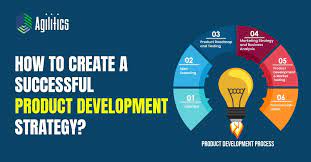Product development is a complex process that requires careful planning, innovation, and execution. Here are several strategies to ensure effective product development:
Market Research and Validation
Conduct thorough market research to understand customer needs, preferences, and pain points.
Validate product ideas through surveys, interviews, and prototype testing to ensure market demand. Cross-Functional Collaboration
Foster collaboration between different teams including product management, design, engineering, and marketing.
Encourage open communication and knowledge sharing to leverage diverse expertise and perspectives.
Agile Methodology
Adopt agile development practices to promote flexibility, adaptability, and rapid iteration.
Break down the development process into smaller, manageable tasks or sprints to deliver value incrementally.
Customer-Centric Approach
Prioritize customer feedback and incorporate it into the development cycle.
Design products with user experience and customer satisfaction in mind to create meaningful solutions.
Prototype and Testing
Develop prototypes or minimum viable products (MVPs) to validate concepts and gather feedback.
Conduct usability testing and iterate based on user input to refine product features and functionality.
Risk Management
Identify potential risks and challenges early in the development process.
Develop contingency plans and mitigation strategies to address unforeseen issues and setbacks.
Scalability and Sustainability
Design products with scalability and sustainability in mind to accommodate future growth and changes.
Consider factors such as scalability, maintenance, and environmental impact during the development phase.
Quality Assurance
Implement rigorous quality assurance processes to ensure product reliability and performance.
Conduct thorough testing at each stage of development to identify and address any defects or issues.
Continuous Improvement
Foster a culture of continuous improvement and learning within the development team.
Gather feedback from customers and stakeholders to inform future iterations and enhancements.
Post-Launch Evaluation
Monitor product performance and user feedback post-launch to identify areas for improvement.
Collect data on key metrics such as user engagement, retention, and satisfaction to measure success.
By implementing these strategies, businesses can streamline the product development process, deliver high-quality products that meet customer needs, and drive long-term success in the market.



